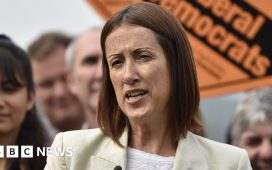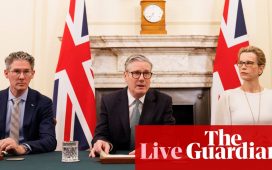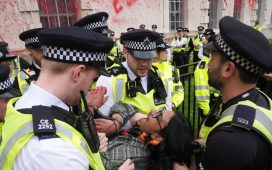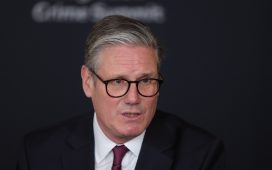King Charles III’s public rejection of a pay rise potentially worth as much as £250m a year in extra taxpayer money has laid bare the extraordinarily generous funding arrangement introduced by the former prime minister David Cameron.
The sovereign grant deal, ushered in by Cameron and his chancellor, George Osborne, in 2011, has already resulted in a sharp rise in public money going to the monarchy over the last decade.
In the first financial year of the deal – 2012-13 – the budget to fund the monarchy was set at £31m. Last year, the monarch received £86.3m, including a substantial amount to refurbish Buckingham Palace. According to the terms of the sovereign grant prescribed in legislation, Charles would potentially be in line for future payments in excess of £330m a year.
£86.3m sovereign grant to the monarchy in 2022
Against the backdrop of a cost of living crisis, the new king has signalled he will forgo some of the cash windfall so it can be spent on the “wider public good”.
However, a delayed review of royal financing has been postponed until after the king’s coronation in May amid scrutiny over Cameron’s funding settlement.
The palace is now refusing to be drawn on the specifics of the king’s financial request, and the Treasury is stalling on whether to release documents relating to the king’s announcement.
At the heart of the problem: the terms of Cameron’s deal with the palace, the most radical shake-up of royal financing in 250 years. The sovereign grant re-established the link between the public funding of the monarch and the profits of the crown estate, which is essentially a state-controlled real estate portfolio that generates revenues for the Treasury.

In January, the crown estate announced a windfarm deal worth approximately £1bn a year. The same day, the palace said the king had asked for an “appropriate reduction” in funding from the extra windfarm profits.
There has been press speculation that the king’s announcement was a shrewd public relations move to pre-empt the Treasury, which had always intended to direct the crown estate windfall to public services.
The palace is refusing to say what the king meant by “appropriate reduction”. The Treasury has missed the legal deadline for responding to a Guardian request under the Freedom of Information Act for papers documenting the precise terms of the king’s request and how the government is responding to it.
Quick Guide
What is Cost of the crown?
Show

What is Cost of the crown?
Cost of the crown is an investigation into royal wealth and finances. The series, published ahead of the coronation of King Charles III, is seeking to overcome centuries of secrecy to better understand how the royal family is funded, the extent to which individual members have profited from their public roles, and the dubious origins of some of their wealth. The Guardian believes it is in the public interest to clarify what can legitimately be called private wealth, what belongs to the British people, and what, as so often is the case, straddles the two.
A ‘generous settlement’
The previous arrangement for channelling public money to the royals, known as the civil list, had been in place since 1760, when the then monarch, George III, gave up the income from the land he owned across the nation and stopped paying for various government functions.
In return, the government would manage the land, which became known as the crown estate. It also agreed to give the monarch an annual fixed sum – the civil list. The arrangement lasted 250 years, ensuring some degree of accountability, with an annual debate over how much taxpayer money should go to the royals.
In his 2019 memoir, Cameron said that while the civil list system was “sensible and enduring, in recent years it had meant a painful annual discussion on every aspect of royal expenditure, accompanied by a tabloid-led debate about whether individual members of the family were ‘good value for money’.” He added: “All that meant that it was almost impossible to increase the money that went to the royals, even though some of their vital infrastructure was crumbling.”
Cameron was a self-described “passionate monarchist” who “ardently supports an institution that is founded on hereditary privilege”. As a 14-year-old Eton schoolboy in 1981, he spent a night in a sleeping bag on the ground outside Buckingham Palace to catch a glimpse of Prince Charles and Lady Diana on their wedding day.

The former prime minister now acknowledges that the sovereign grant that he and Osborne introduced in the wake of the 2008 financial crisis – and amid cuts to public sector in the name of “austerity” – turned out to be a “generous settlement” for the royal family.
Declassified documents show Buckingham Palace had been lobbying as far back as the 1980s, when the Conservative prime minister Margaret Thatcher was in power, to reconnect its funding model to the crown estate profits. Their efforts appear to have been unsuccessful until the Tory-led coalition government came into power in 2010.
Cameron and Osborne decided the equivalent of 15% of crown estate profits should be allocated to fund the monarchy’s official work, such as the royal staff, visits, receptions, garden parties and property maintenance.
When the new mechanism was approved by MPs, Osborne said the arrangement pegged royal funding to the profits of a “large, conservatively run property company”, which would reflect how well the economy as a whole was performing, or, as he put it, the royal family “will do as well as the economy is doing”. The chancellor also said the sovereign grant would ensure the monarchy remained “above the annual political fray”, and claimed that “the amount of money going from the public purse to the royal family” would remain broadly the same.
A “golden ratchet” clause in the deal ensured that while funding for the monarchy could increase in line with crown estate profits, it was guaranteed never to fall. If the crown estate profits dipped, the Treasury was legally required to top up the shortfall to ensure that, at a minimum, the monarch would be paid the same as the preceding year. This clause has kicked in twice, ensuring that in the two most recent rounds of public funding, the Treasury has topped up the amount of money being given to the monarchy with an extra £27m over the two years.
How much is enough?
Three individuals – the prime minister, the chancellor and the monarch’s treasurer, known as the keeper of the privy purse – are responsible for deciding how much public funding is channelled to the royal family.
In 2017, Theresa May, Philip Hammond and Sir Alan Reid decided public funding should be increased – on a temporary basis – from 15% to 25% of the crown estate’s profits. The increase would be spent specifically on a 10-year programme, costing £369m, to refurbish Buckingham Palace.

Courtiers argued that ageing cables, lead pipes, wiring and boilers needed to be replaced, many for the first time since the 1950s, amid fears about potential fire and water damage. However, the steep rise in the sovereign grant is not just attributable to the palace repair costs: strip away the extra money for the palace, and the core grant has increased well above the rate of inflation.
The government is reviewing whether the level of public funding for the Windsors, tied to crown estate profits, is appropriate.
Run as a commercial enterprise, the crown estate makes large profits – more than £300m a year – from a £15.6bn portfolio that includes high-grade urban property in London’s West End, prime farmland, and office buildings and retail parks in cities from Southampton to Newcastle.
As the owner of large parts of Britain’s seabed and coast, it can generate profits from oil and gas drilling rights and royalties, as well as wind and wave farm developments. In January, it announced deals for six offshore wind projects that will provide about £1bn a year, prompting an announcement from Buckingham Palace that same day.
A palace spokesperson said: “In view of the offshore energy windfall, the keeper of the privy purse has written to the prime minister and the chancellor to share the king’s wish that this windfall be directed for wider public good, rather than to the sovereign grant, through an appropriate reduction in the proportion of crown estate surplus that funds the sovereign grant.”
The sovereign grant was intended to simplify royal finances by combining several grants from different departments into one. But it does not take into account the roughly £40m a year that the monarch and the male heir to the throne – now Prince William – receive from the duchies of Lancaster and Cornwall respectively. The palace insists this income is private, but it has been the subject of a centuries-old debate over whether the profits should in fact go to the public.
Neither is the sovereign grant comprehensive. The government continues to foot the bill of royal costs deemed to fall outside its remit, using funds from the Ministry of Defence, the Home Office, the Department for Culture, Media and Sport, and the Foreign, Commonwealth and Development Office.
The palace and the government have not said how much taxpayer money went towards the funeral of Queen Elizabeth II, or how much of it will pay for the coronation of King Charles III next month. Both have said figures will be released “in due course”.
A spokesperson for Buckingham Palace said: “Revenues raised by the crown estate are a matter for the crown estate and HM Treasury.” A Treasury spokesperson said: “The palace has been clear that profits from the latest wind leasing programme should be used for the wider good of the nation.”










